Weak Gravitational Lensing, Galaxy-Galaxy Lensing, Dark Matter, Dark Energy, Galaxy Formation, Cosmology, Large-Scale Structure, Groups and Clusters of Galaxies.
Weak Gravitational Lensing
Weak lensing is a powerful technique, which measures distortions in the shapes of distant galaxies to infer how the gravitational field of massive objects bends the paths of approaching light rays. Weak lensing is recognized as a fundamental tool for observational cosmology, on par with studies of Supernovae and Baryon Acoustic Oscillations. The strength of this method is that it probes the total intervening mass distribution, including the dark matter component. Furthermore, by tracking the growth of this mass distribution as the universe expands, weak lensing also provides a measure of dark energy. I specialize in the design, analysis, and theoretical interpretation of gravitational lensing imaging surveys (maps of the sky containing millions of galaxies). My group has been involved in the COSMOS weak lensing survey (2 square degrees), the CFHT Survey of Stripe 82 (170 square degrees), and a new unprecedented effort to map 1400 square degrees of the sky using the Subaru Telescope (the HSC survey). Within the next decade, weak lensing will become an even more powerful cosmological tool with upcoming surveys such as WFIRST and the Large Synoptic Survey Telescope (LSST).
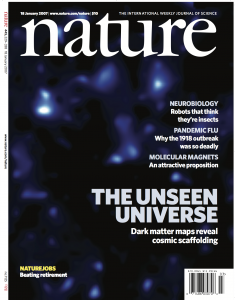
Multi-Probe Cosmology
The galaxies that we observe are biased tracers of the underlying dark matter density field. This hampers our ability to extract cosmological information from galaxy surveys. I work on methods that aim to combine the information contained within the galaxy distribution (galaxy clustering) with measurements of the dark matter halos that surround galaxies (probed via galaxy-galaxy lensing). This muti-probe approach is a powerful way to constrain the growth of cosmic structures with time. Recently, I showed that the clustering properties of the BOSS CMASS sample (a key data-set of very luminous and red galaxies used in a variety of cosmological studies) predicts a gravitational lensing signal that is 30% higher than observed (Leauthaud et al. 2017). I am working to understand this discrepancy and to perform a new an independent measurement of this effect using new data sets with larger constraining power (clustering from DESI and lensing from HSC). I am also interested in multi-probe methods to combine weak lensing and lensing from the Cosmic Microwave Background (see Hand et al. 2015).
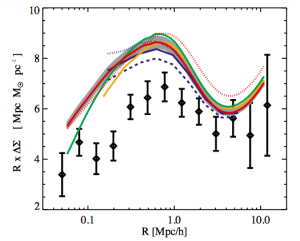
Stellar-to-Halo Mass Relation
Pinning down the relationship between dark matter halo mass Mh and galaxy mass M* is one of the key steps towards understanding the link between galaxy growth and halo growth. A variety of observations have now shown that galaxies convert baryons into stars with a star conversion efficiency that depends strongly on halo mass, peaking at Mh~10^12 Msun and declining towards lower and higher masses at z=0 (see figure on the right). However, there are many details that are still unknown. What is the scatter in the stellar-to-halo mass relation? What are the physical causes that lead to this scatter? Does this scatter vary with halo mass? How does the stellar-to-halo mass relation vary with galaxy properties (color, sizes, star formation rates). My team is working to answer these questions using state-of-the art measurements of weak lensing and new large panchromatic surveys.
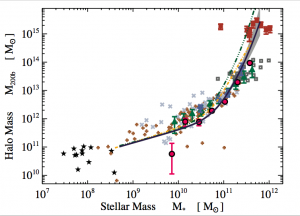
Stellar-Halos
Giant elliptical galaxies such as the one shown on the right have light profiles that can extend out to hundreds of kpc. These extended outskirts are known as as stellar halos or stellar envelopes. Not all galaxies display these massive extended wings, and there is a large range in the diversity of these stellar envelopes. My team is working to understand the primary physical mechanisms by which massive galaxies build their stellar envelopes. In particular, we are trying to tease out the connection between the growth of these extended wings, the assembly history of galaxies, and the assembly histories of their dark matter halos. In general, I am interested in all aspects of the the formation of massive galaxies. Check out our webpage dedicated to understanding Massive Galaxies.
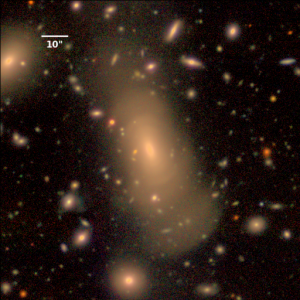
Dwarf Galaxies & the Merian Survey
While the dark matter distributions around massive galaxies, groups, and clusters have been successfully studied with lensing and kinematics, mapping the dark matter profiles in dwarf galaxies (M*<10^9 Msun) is more challenging. Some of the most dark-matter dominated galaxies in the Universe are dwarf galaxies, and these galaxies harbor unique clues to the roles of star formation feedback and environmental processing in the establishment of the stellar-to-halo mass relation. However, current lensing measurements do not extend below 10^9 Msun. Below this mass, we have relied on rotation curves, or globular clusters, to probe the inner parts of the halo. With new large fields, but also deep lensing surveys, the situation is about to change. My team is trying to understand how to harness the power of new lensing surveys to enable us, for the first time, to study the dark matter halos of galaxies with M*<10^9 Msun with gravitational lensing. The Merian survey (2021-2023) will use 62 nights on the Blanco telescope and will build a sample of 100,000 dwarf galaxies. Among other things, Merian will measured the halos of dwarfs with gravitational lensing.
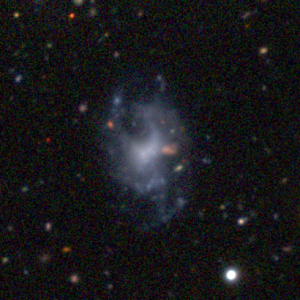
Other Research Highlights
In collaboration with Berkeley graduate student Nick Hand we published the first measurement of the cross-correlation between CMB lensing and galaxy lensing (Hand et al. 2015).
In collaboration with Beth Reid, we published the first fit to the anisotropic clustering of Sloan Digital Sky Survey III "CMASS" galaxies on scales below 40 h-1 Mpc. Though model dependent, our measurement represents a 2.5 per cent measurement of the growth rate (Reid et al. 2014).
With former Berkeley graduate student Matt George, we produced a group membership catalog for a sample of ~160 X-ray selected groups in COSMOS. This catalog has been made public and you can find the details in George et al. 2011 and you can also download our catalog from the COSMOS IRSA database.